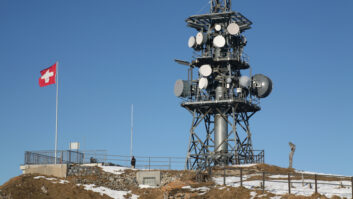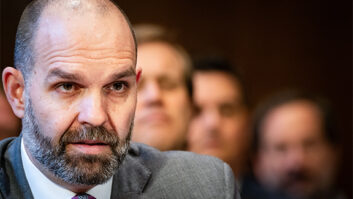The FCC’s Broadcast Flag for DTV Is Under Siege. The Outcome Will Weigh on Digital Radio
This column has previously considered the so-called “Broadcast Flag” scheme that will soon go into effect for digital television, as a possible precursor to similar regulations that might be applied to digital radio (RW, Dec. 15, 2004, and Jan. 5, 2005). You may recall that this process is intended to restrict consumers’ ability for, in the FCC’s words, “mass, indiscriminate redistribution” of content received via digital television broadcasts, without the requirement for broadcasters to encrypt the transmission of these signals.
In other words, DTV can be broadcast “in the clear,” but once received, consumer equipment must apply an FCC-approved form of content protection to all flagged content, and downstream consumer equipment must observe rules that allow this content to be decrypted only under approved conditions. These rules are set to become effective on July 1, after which no DTV receivers or downstream consumer equipment can be sold in the United States without observing the Broadcast Flag rules.
The Hollywood movie studios, as represented by their trade association, the Motion Picture Association of America, has driven this process through the FCC, with the support of many broadcasters, who feel that without it they will be denied future access to the most desirable content for DTV broadcast, and that this content would then migrate to inherently more secure digital cable and satellite television distribution.
NAB PresidentsQuick, name any three presidents of the National Association of Broadcasters prior to Eddie Fritts.
You might be forgiven for not knowing, given that Fritts, now in his last term, has held the job since the first Reagan administration, and that his predecessor took the post when LBJ was in the White House. Here’s the list, courtesy of NAB:
Eugene F. McDonald 1925
Frank W. Elliott 1925-26
Earle E. Anthony 1926-28
William S. Hedges 1928-30
Walter J. Damm 1930-31
Harry Shaw 1931-32
Alfred J. McCosker 1932-34
Truman Ward 1934-35
Leo J. Fitzpatrick 1935-36
Charles W Myers 1936-37
John Elmer 1937-38
Mark Ethridge 1938
Neville Miller 1938-44
Harold J. Ryan 1944-45
Justin Miller 1945-1951
Harold E. Fellows 1951-1960
LeRoy Collins 1961-64
Vincent T. Wasilewski 1965-82
Edward O. Fritts 1982-present
The FCC has taken great pains to point out that acceptable conditions for decryption of flagged content include all fair-use rights of consumers to view, record, copy and replay content – no different than those that exist for analog TV today – and that the Broadcast Flag process is not really content protection per se, but simply a “speed-bump” constraint to peer-to-peer or Web redistribution of content received via DTV. Others hold different views on the Broadcast Flag, however, and this debate has recently moved to the courts.
Meanwhile, the Recording Industry Association of America has made comments to the FCC in its NOI on digital radio content protection, supporting a scheme similar to the DTV Broadcast Flag for application to published music content broadcast via HD Radio. Thus the outcome of the current court case on the DTV Broadcast Flag, and any subsequent actions, could have considerable impact on digital radio’s future.
The lawsuit
In January, a number of non-profit organizations filed suit against the FCC over the DTV Broadcast Flag. The groups included consumer advocates and library trade associations (Public Knowledge, the Electronic Frontier Foundation, Consumers Union, Consumer Foundation of America, the American Library Association, Association of Research Libraries, American Association of Law Libraries, Medical Library Association and Special Libraries Association). The venue for the case was the District of Columbia Circuit of the U.S. Court of Appeals.
In their case, these groups made the point that the Broadcast Flag process effectively will go far beyond the professed purpose of preventing the (already illegal) Internet redistribution of content, and it would unavoidably impact consumers’ and others’ content usage rights and convenience. They contended that the consumer usage environment for Broadcast Flag-enabled DTV will be substantially different than for analog TV, and that significant interoperability problems may be created by the Broadcast Flag system.
From a legal perspective, they challenged the FCC’s jurisdiction to enact a scheme that mandates such broad product design rules for consumer equipment, as well as one that, in effect, sets new copyright policy. They also felt that, even if the FCC had such jurisdiction, the action was arbitrary and capricious (and therefore illegal), and unwarranted in the face of unsubstantiated harm to the content companies. Further, even if such harm existed, the Broadcast Flag would not effectively solve the problem anyway.
An initial judgment
Oral arguments at the Court of Appeals were heard in February, at which the majority of the three-judge panel appeared strongly sympathetic to the plaintiffs’ case. The judges effectively roasted the FCC’s counsel defense of the flag, with two of them openly chastising the commission for overstepping its jurisdiction by enacting the flag without explicit congressional mandate. The FCC replied that they felt this authority came with the commission’s order from Congress to manage the DTV transition, but the judges seemed to disagree.
Notwithstanding the merits of the plaintiffs’ case, however, the issue of their “standing” loomed large to the judges, as well. This point of law reflects the basic need for any plaintiff to present to the court’s satisfaction a specific harm that the plaintiff would suffer. The court pointed out that all of the plaintiffs represented members who would not be harmed any more than the general public by the Broadcast Flag, therefore the plaintiffs’ standing to make the appeal was questioned. If the plaintiffs had represented a group that would be specifically or uniquely impacted by the FCC’s action in the case (such as a consumer equipment manufacturer), such standing would not be questioned; but no such entity was among the plaintiffs.
Such a clear statement of standing by the plaintiffs is a prerequisite for the merits of the case to be considered, so the appeal could not proceed without the question of standing being settled first. Somewhat surprisingly, on March 15 the court quite promptly issued (by a 2-1 ruling) what amounted to an interim decision on the case, calling for the plaintiffs to better articulate their standing. (The dissenting judge felt that the standing issue warranted dismissal of the case.)
Some expert observers concluded that the court was providing the plaintiffs with a roadmap for showing standing in the absence of direct harm, because they feel so strongly on the merits of the case and want to rule on it. Others feel that the court is showing understanding for the reluctance of any party with true standing to come forward, given the chilled context that a maker of consumer media-consumption equipment is confronted with in challenging the content community that creates and delivers the products that its devices consume.
Overall these oddsmakers are therefore expecting this court to ultimately reject the Broadcast Flag and force the FCC to rescind these rules. Meanwhile, the consumer electronics industry still faces the July 1 deadline for updating its product inventory for Broadcast Flag support, and until a ruling to the contrary is issued, manufacturers have to assume that the existing rules will go into effect as scheduled.
Given the timetable as understood at press time, however, both the plaintiffs and the FCC will have responded with their briefs requested by the interim ruling by now, and a final decision could be rendered prior to (or soon after) the July 1 date.
Next steps
If the flag rules are indeed rejected by the appeals court, the FCC and/or MPAA could pursue the case further in the courts, but meanwhile Capitol Hill observers have reported that the MPAA is already lobbying Congress to add language to a currently pending bill on the DTV transition that would explicitly grant the FCC jurisdiction to mandate the Broadcast Flag. This issue is therefore currently at play in all three branches of the U.S. federal government.
While there are certainly differences between digital television and radio, when it comes to the issue of Internet redistribution of copyrighted digital content, the music industry is the poster child, so digital radio will not escape the spotlight of association with it.
The stakes and interest levels on this issue in both the public and private sectors are sufficiently high that it will not soon fade from the radar, and the scope of those screens will certainly include digital radio. As the flag flies for DTV, so will it eventually unfurl o’er the land of IBOC.







